Night hunting has gained popularity among hunters looking to target nocturnal game like hogs, coyotes, and other predators. Using the right hunting lights can significantly improve visibility and success in low-light environments. Two of the most common lighting options for night hunting are green and red lights, each offering unique advantages. In this guide, we’ll compare green hunting lights and red lights to help you decide which is best for your next night hunting adventure.
1. Understanding the Basics of Night Hunting Lights
When it comes to night hunting, the type of light you use can impact how well you see your target and how effectively you stay concealed. Different colored lights affect visibility, target detection, and even the behavior of animals.

- Green Solar Lights: Green lights are popular among hunters because they allow for greater visibility at longer distances while minimizing spooking the game.
- Red Lights: Red lights offer a softer illumination, reducing the chance of alerting animals, as red light tends to be less visible to most nocturnal species.
Both green and red hunting lights are available in various forms, including solar-powered options, making them convenient and eco-friendly choices.
2. Advantages of Green Hunting Lights
a) Greater Visibility at Longer Distances
One of the key benefits of using green hunting lights is their ability to illuminate greater distances. Green light penetrates through darkness more effectively than red, allowing hunters to see the landscape and spot game from a greater range. This is especially useful when hunting animals like hogs that tend to be active over large areas.
b) Enhanced Eye Contrast
Green light enhances the contrast of animal eyes, making it easier to detect wildlife. This is particularly helpful for hog hunters and those targeting predators. The light reflects off the eyes of the game, making them stand out against the dark environment.
c) Solar-Powered Green Lights
Many solar-powered hog hunting lights use green LEDs, making them an eco-friendly option. They charge during the day and provide reliable illumination throughout the night, without needing to replace batteries frequently. These lights are easy to set up in remote areas and can be positioned to illuminate feeding or bait stations.
3. Advantages of Red Hunting Lights
a) Reduced Game Spook
One of the biggest advantages of solar red lights is that animals, particularly nocturnal ones like hogs and coyotes, are less likely to notice red light. Red light is less intense than green, making it less likely to alert the game to your presence, allowing you to remain concealed and get closer to your target.
b) Less Eye Strain
Red light is gentler on human eyes than green light, causing less strain during extended use. This makes red hunting lights a great option for long hours of night hunting, especially when scanning areas for extended periods.
c) Solar-Powered Red Lights
Solar red lights are another efficient option for night hunting. Like their green counterparts, they charge during the day and provide consistent illumination throughout the night. This ensures you are prepared for longer hunting trips without the need for regular battery replacements.
4. Green vs. Red Lights: Which is Better for Different Game?
Different game species react differently to colored lights, so it’s essential to choose the right color depending on what you’re hunting:
-
Hogs: Green lights tend to work better for hog hunting as hogs are not as sensitive to green wavelengths, allowing hunters to spot them at greater distances. Solar-powered hog hunting lights can be placed near feeders or bait stations to illuminate hogs during their feeding times.
-
Coyotes and Predators: Predators like coyotes are more sensitive to green light, so red lights are often preferred for these species. Red light is less likely to spook these animals, allowing for a stealthier approach.
-
General Use: For hunters targeting a variety of nocturnal species, having both red and green hunting lights on hand can be advantageous. Switching between the two can help adapt to different hunting scenarios and game behavior.
5. Factors to Consider When Choosing Between Green and Red Lights
a) Type of Game
The type of game you're targeting should heavily influence your choice of light. Green solar lights work well for hogs, while red lights are ideal for coyotes and other predators.
b) Distance
Green lights are better for long-distance visibility, whereas red lights are preferred for closer range and more discreet hunting.
c) Durability and Power Source
Solar-powered hunting lights are an excellent choice for those looking for a sustainable and reliable power source. They can be set up ahead of time at hunting locations and are less likely to die during critical moments of your hunt.
Conclusion: Which Hunting Light Is Right for You?
Choosing between green and red hunting lights comes down to the type of game you're hunting, the environment, and personal preference. Green lights provide superior visibility at longer distances and are ideal for hog hunting, while red lights offer discretion and are less likely to spook predators like coyotes.
Looking to upgrade your night hunting gear? Explore Langy Energy’s full range of solar-powered hunting lights and make your next night hunting trip a success with eco-friendly, powerful lighting solutions!

